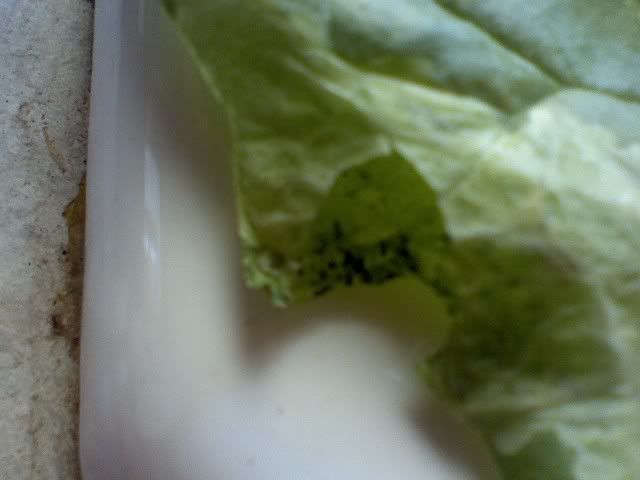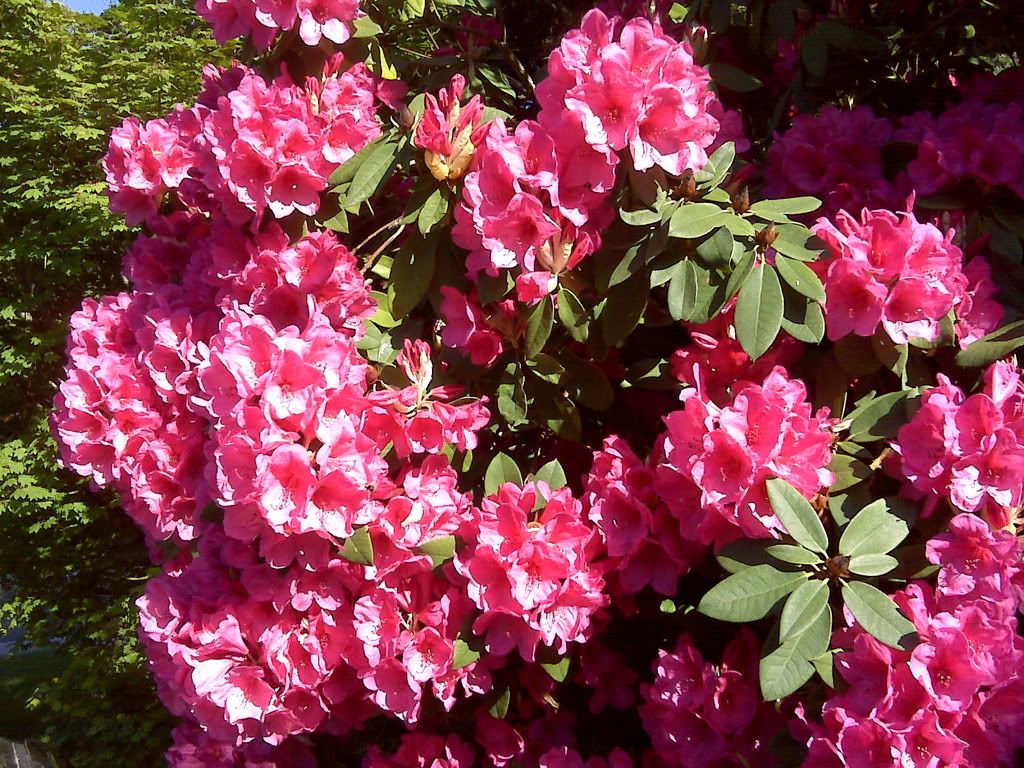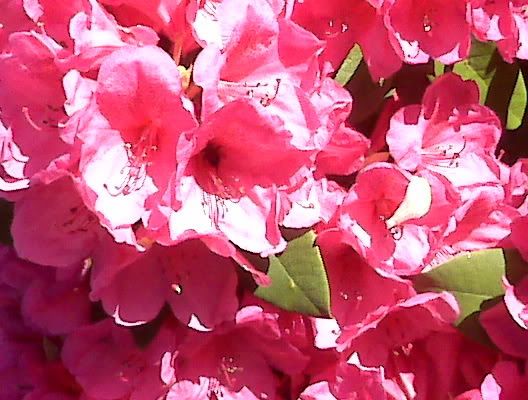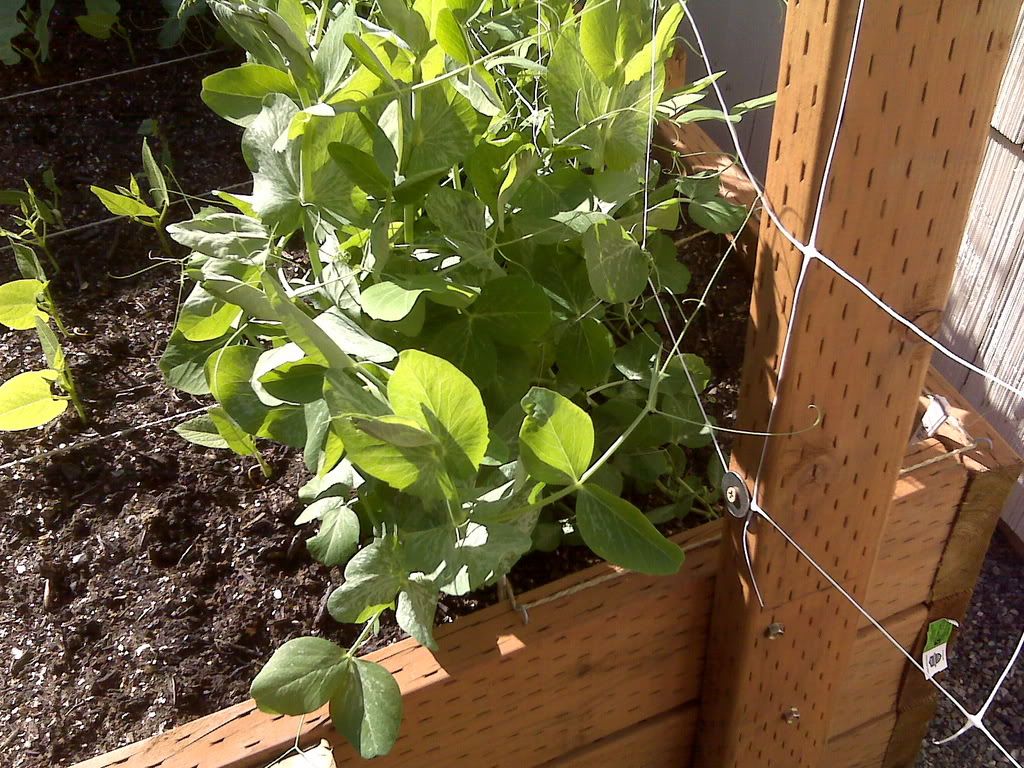
Well, thanks to Tim, it appears that I now know what what's turning my spinach leaves white. Apparently I've been attached by Spinach Leaf Miners. What little I found online tracks with what I found on the leaves. Unforunately when Tim said I would find a couple of black specs between the leaf layers, I found dozens. The adults are flies but the larve turn into white moths. Don't ask me, I don't make this stuff up. I'm guessing the small black flies I found all over the place under my hoop covers were the adults laying eggs. I thought they were harmless. Boy was I wrong. Great way to start gardening, hehe.
Anyway, according to Tim they're "bad news" but all I could find as to how to take care of them at this point was to destroy the white parts. The rest of the leaf is ok to eat. So I'll use as much of the spinach as I can to make the salad this weekend. Unfortunately under most of the mature leaves I found small white dashes which is a sign of the start of infestation.
What I don't understand is everywhere says to prevent the infestation in the first place, put a row cover over the bed early on to keep the flies away from them. Um, I swore I DID that!!! Maybe I should have made a better seal and used insect cloth rather than the 4 mil plastic. Of course that wouldn't have protected the plants from frost.
I know I won't be planting spinach in those squares anytime again soon, but I hope I can continue to grow the seedlings that I have in various stages in three squares in that area. Thankfully they're not going for the lettuce and I am not planting any other veggie they like (chard, beets and sugar beets). I just hope it wasn't in the compost I got and thus is in all my beds. Apparently this isn't something I could even use insecticide on. Though if I spot the eggs I can squish them before they hatch. Something to watch for next time I plant spinach. And I may want to invest in a magnifying glass, hehe.
I also wonder if i should worry about any spinach stalks and maybe a white splotch that may have made its way into my compost bin before I knew what it was.
Oh, and if I sound less than panicked, it's because ignorance is bliss.
Other than that, I've got a few more pics for you. First I couldn't help but notice this beautiful rhodie, I parked under it, hehe.

Oh, and of course there were bumble bees at work. This time I got a shot of one. Busy as a bee...

Finally, anyone know how to convince my peas not to follow the light?

I thought only seedlings indoors did that. But these peas are clearly ignoring the beautiful trellis I made for them. Instead they're crowding the next square reaching southward. Hehe I recall someone saying that pole beans took up such little space that you could use the outer part of the square for other plants. I can't even use the next square for my beans. The peas crowd them out. See the bean sprouts on the far left? That's the middle of the square! Nothing grows in the northern half. I wonder if I should use my twist ties to "train" them up the trellis. So far all I've done is "grab" the trellis with the pea tendrils. They bow pretty good but hold on tight.
Hope your garden is less troublesome than mine right now.
Enjoy your garden!
I have a few columbine plants around the yard and they always have these tunnel patterns on the leaves, in researching your leaf miner problem I found out this is what is on my columbine plants. I also read that you can plant columbine plants as kind of a host plant to keep them off other plants, might be worth a try next year. I also found a link that they are breeding a spinach that is resistant to leaf miner Link
ReplyDeleteI have been dreading the arrival of the cucumber beetle & potato beetle already and I am hoping it will not be a bad year. I guess time will tell.
oh yeah, forgot to add that your new phone takes great photo's!
ReplyDeleteYes, you can remove the damaged portions of the leaves and leave the rest. This should remove the miners as you do it. The sooner the better as the miners gain size and momentum. You do seem to have "Spinach Leaf Miners" which is a bit different that the ones I have in my beets and swiss chard, but they're pretty similar.
ReplyDeleteMost peas nowadays are dwarfed varieties and even though they are sprawling vines, they won't use a trellis even when offered. Loosely quoted from Steve Solomon's excellent book "Growing Vegetables West of the Cascades" which you ought to have if you don't already. Some people use a jumble of sticks for support. Others a low wire mesh fence just to contain the sea of vines from overflowing. Others use nothing at all.
My trellis is just nylon twine strung vertically (4 per foot) and I just take the branches with the tendrils and wrap them around and around the twine. What I found is that if I do more than just the tendrils it works better. So I start as close to the main trunk as possible and wrap the whole branch, leaves and all, up until the tendrils start getting wrapped. This seems to work pretty well.
ReplyDeleteWhen possible I also try to wrap the main trunk around the twine too but often I can't move it close enough to the twin without breaking the plant.
The only pictures I have online are from late April when they were less than a foot tall so I'm not sure if they help.
http://www.harrisnotes.com/photos/2008/2008-04-29_garden/jbh20080429-garden-02-sm.html
One thing I realize looking back is it worked way better once they got up to where the twine is strung very taught. It was hard for them to latch on when they were down on the loose part of the twine.
By the way, you could probably plant these earlier next year. I planted my peas February 27th and they are now probably 5 feet high. They don't mind the cool weather. I have lots of pea-flowers and have a couple pea-pods already forming. (oh I live in south Seattle near Boeing Field)